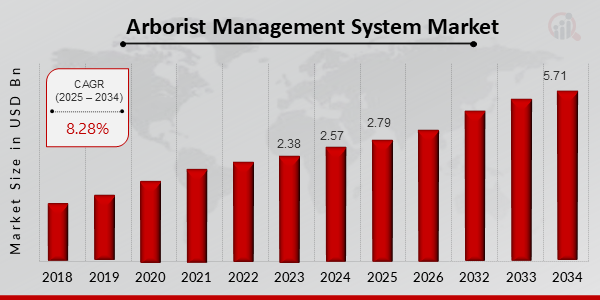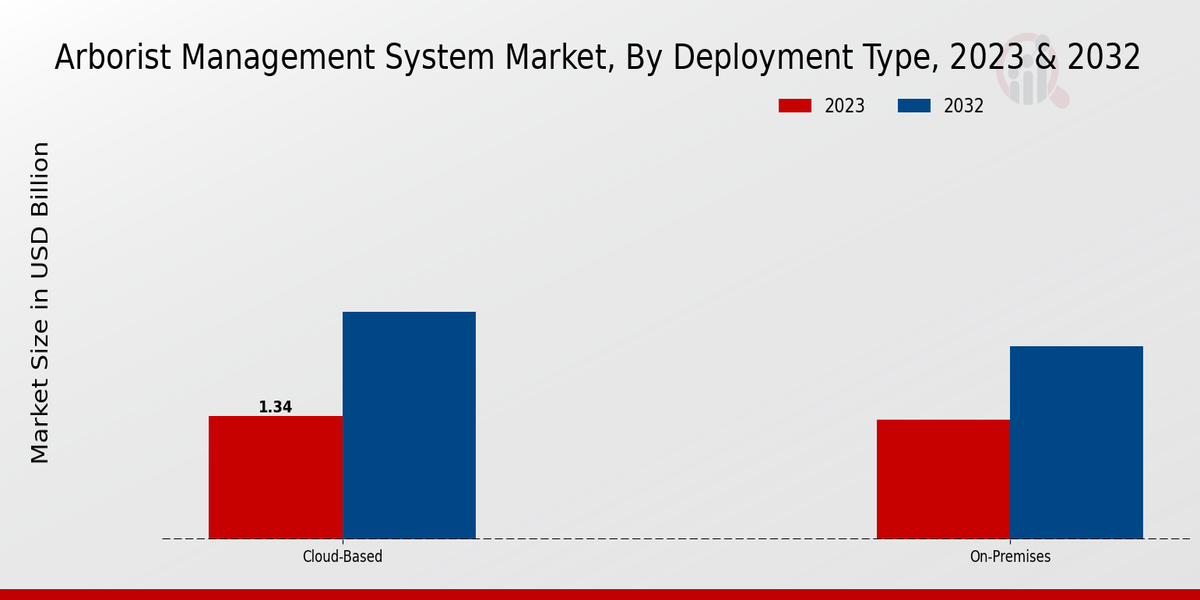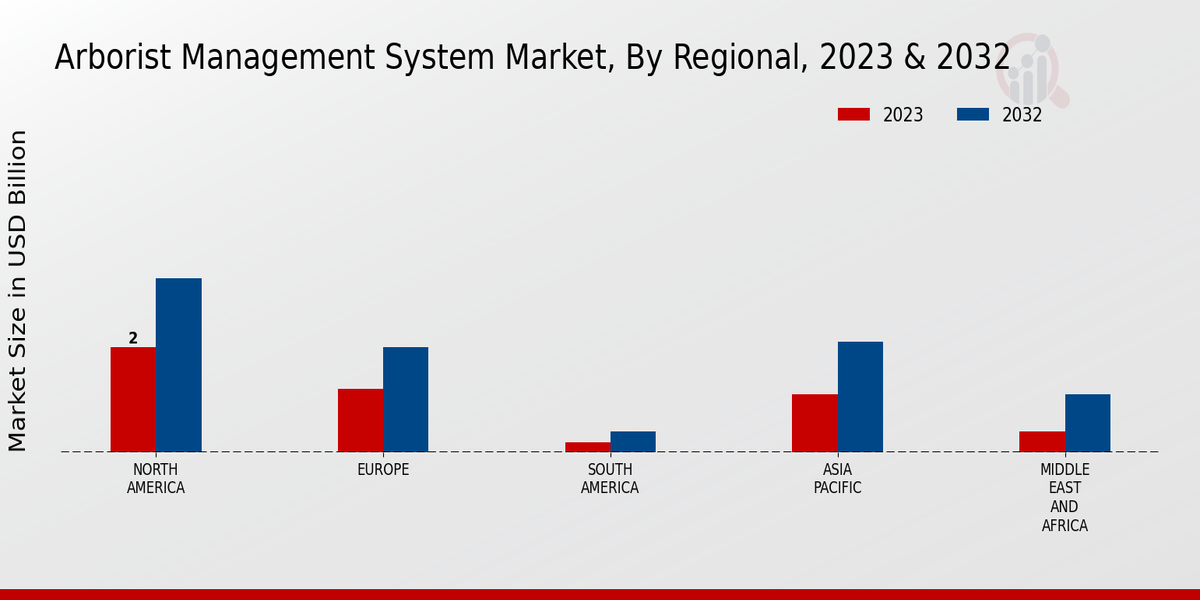Arborist Management System Market Overview
Arborist Management System Market is projected to grow from USD 2.79 Billion in 2025 to USD 5.71 Billion by 2034, exhibiting a compound annual growth rate (CAGR) of 8.28% during the forecast period (2025 - 2034). Additionally, the market size for Arborist Management System Market was valued at USD 2.57 billion in 2024.
Key Arborist Management System Market Trends Highlighted
Emerging advancements in arboriculture, including tree mapping and risk assessment tools, are driving the need for comprehensive arborist management systems. The increasing focus on urban forestry and tree preservation mandates efficient management and documentation practices to ensure tree health and public safety. Opportunities abound for vendors to capture market share by integrating advanced technologies such as drones, remote sensing, and mobile applications. These technologies enhance data collection, reporting, and decision-making, streamlining arborist operations and improving tree care outcomes.
Recent trends in the arborist management system market include the adoption of cloud-based platforms, which offer improved accessibility, data storage, and collaboration. Additionally, the growing demand for sustainability initiatives is driving the integration of environmental and social impact tracking capabilities into these systems. As arborists strive to optimize tree management practices, innovative and data-driven solutions continue to shape the market's trajectory.
Figure 1: Arborist Management System Market, 2025 - 2034

Source: Primary Research, Secondary Research, MRFR Database and Analyst Review
Arborist Management System Market Drivers
Rise in Demand for Efficient Tree Management
The growing urbanization and population density have led to an increase in the number of trees in cities and urban areas. This has created a need for efficient tree management systems to maintain the health and safety of trees, as well as to minimize the risks associated with tree-related accidents. Arborist management systems provide a centralized platform for managing all aspects of tree care, including inventory, inspection, maintenance, and removal. These systems help arborists and tree care professionals to work more efficiently and effectively, which has led to a rise in demand for these systems globally.
In addition, the increasing awareness of the environmental benefits of trees has also contributed to the growing demand for arborist management systems. Trees provide numerous environmental benefits, such as air purification, carbon sequestration, and stormwater management. Arborist management systems help to ensure that trees are properly cared for and maintained, so that they can continue to provide these benefits for years to come.
Furthermore, the growing adoption of smart city technologies is also driving the demand for arborist management systems. Smart city technologies are being used to improve the efficiency and effectiveness of urban infrastructure and services, and arborist management systems are an important part of this trend. These systems can be integrated with other smart city technologies, such as GIS systems and asset management systems, to provide a comprehensive view of the urban forest and to help cities make better decisions about tree care and management. Overall, the rise in demand for efficient tree management, the increasing awareness of the environmental benefits of trees, and the growing adoption of smart city technologies are all contributing to the growth of the Arborist Management System Market.
Technological Advancements in Arborist Management Systems
The arborist management system market is witnessing continuous technological advancements that are enhancing the capabilities and functionality of these systems. These advancements include the integration of advanced technologies such as artificial intelligence (AI), machine learning (ML), and the Internet of Things (IoT). AI and ML algorithms are being used to develop automated tree inspection and analysis tools that can identify potential hazards and diseases early on.
These tools can help arborists to prioritize their work and to take proactive measures to prevent tree-related accidents. IoT devices are being used to monitor tree health in real time and to provide early warning of any potential problems. This information can be used to trigger automated responses, such as irrigation or fertilization, to help keep trees healthy and safe. In addition, the use of mobile technologies is also increasing the accessibility and usability of arborist management systems. Mobile apps allow arborists to access and update tree data in the field, which can save time and improve efficiency. These apps can also be used to provide real-time updates on tree health and safety, which can help to improve decision-making and risk management.
Government Regulations and Standards for Tree Care
Government regulations and standards for tree care are becoming increasingly stringent in many countries around the world. These regulations are being put in place to protect trees from damage and disease and to ensure that trees are properly managed and maintained. This is leading to a growing demand for arborist management systems that can help arborists and tree care professionals comply with these regulations. Arborist management systems can help arborists track and manage tree inventory, identify and assess tree hazards, and develop and implement tree care plans.These systems can also help arborists to communicate with property owners and other stakeholders about tree care needs and to document their work. By using arborist management systems, arborists can help to ensure that trees are properly cared for and maintained, and that they comply with all applicable regulations and standards.
Arborist Management System Market Segment Insights
Arborist Management System Market Deployment Type Insights
The Arborist Management System Market is segmented by deployment type into cloud-based and on-premises. The cloud-based segment is expected to dominate the market over the forecast period, owing to its benefits, such as scalability, flexibility, and cost-effectiveness. The on-premises segment, on the other hand, is expected to witness a steady growth rate during the forecast period due to the need for data security and control. In 2023, the cloud-based segment accounted for more than 60% of the Arborist Management System Market revenue.
The growth of this segment is attributed to the increasing adoption of cloud-based solutions by businesses of all sizes. Cloud-based solutions offer several advantages over on-premises solutions, such as lower upfront costs, scalability, and flexibility. They also allow businesses to access their data and applications from anywhere with an internet connection. The on-premises segment is expected to grow at a CAGR of over 5% during the forecast period. This growth is attributed to the need for data security and control. On-premises solutions provide businesses with more control over their data and applications, and they are also less vulnerable to security breaches.
Overall, the Arborist Management System Market is expected to grow at a CAGR of over 7% during the forecast period. The growth of the market is attributed to the increasing adoption of arborist management systems by businesses of all sizes. Arborist management systems help businesses to manage their arborist operations more efficiently and effectively, and they can also help to improve safety and compliance.
Figure 2: Arborist Management System Market, By Condition, 2023 & 2032

Source: Primary Research, Secondary Research, MRFR Database and Analyst Review
Arborist Management System Market Application Insights
The Arborist Management System Market is segmented by Application into Tree Inventory and Management, Work Order Management, Scheduling and Dispatching, Asset Management, and Customer Relationship Management (CRM). In 2023, the Tree Inventory and Management segment held the largest market share of 35%, owing to the increasing need for efficient tree management and maintenance. The Work Order Management segment is expected to grow at the highest CAGR of 12.5% during the forecast period, driven by the rising demand for digitized work order management solutions.
Arborist Management System Market End-User Insights
The Arborist Management System Market segmentation by end-users includes arborists, municipalities, utilities, landscapers, and property managers. Arborists accounted for the largest share of the market in 2023, and they are expected to continue to dominate the market over the forecast period. The growing demand for tree care services, such as tree pruning, removal, and planting, is driving the growth of the arborist segment. Municipalities are another major end-user of arborist management systems. Municipalities use these systems to manage their urban forests, which include trees in parks, streets, and other public areas.
The growing awareness of the importance of urban forests is driving the growth of the municipality segment. Utilities are also significant end-users of arborist management systems. Utilities use these systems to manage trees near power lines and other infrastructure. The increasing focus on safety and reliability is driving the growth of the utility segment. Landscapers and property managers are other end-users of arborist management systems. Landscapers use these systems to manage trees on commercial and residential properties. Property managers use these systems to manage trees on multi-family properties. The growing demand for landscaping and property management services is driving the growth of the landscapers and property managers segment.
Arborist Management System Market Tree Species Insights
The Arborist Management System Market is segmented based on tree species into Deciduous Trees, Coniferous Trees, Palm Trees, Fruit Trees, and Flowering Trees. Among these, Deciduous Trees are expected to account for the largest revenue share in the market due to their widespread presence in urban and suburban areas. These trees shed their leaves annually, which can create a significant amount of debris that needs to be managed. Coniferous Trees are also expected to hold a significant market share due to their popularity as ornamental trees. These trees retain their leaves throughout the year, which can help to reduce the amount of debris that needs to be managed. Palm Trees, Fruit Trees, and Flowering Trees are expected to account for a smaller share of the market due to their more limited distribution and use.
Arborist Management System Market Regional Insights
The regional segmentation of the Arborist Management System Market offers insights into the market's geographic distribution and performance. North America currently dominates the market, accounting for a significant share of the Arborist Management System Market revenue. The region's mature arboriculture industry, advanced technological adoption, and strong demand for arborist management solutions contribute to its leading position. Europe is another major market, driven by the presence of established arboriculture practices and regulations.
The APAC region is projected to witness substantial growth in the coming years, fueled by increasing urbanization, rising awareness about tree care, and government initiatives promoting sustainable urban development. South America and MEA are emerging markets with untapped potential, presenting opportunities for growth and expansion.
Figure 3: Arborist Management System Market, By Regional, 2023 & 2032

Source: Primary Research, Secondary Research, MRFR Database and Analyst Review
Arborist Management System Market Key Players And Competitive Insights
Major players in the Arborist Management System Market industry are continuously striving to gain a competitive advantage by adopting various strategies such as product innovation, mergers and acquisitions, and strategic partnerships. Leading Arborist Management System Market players are making significant investments in research and development to enhance their product portfolio and cater to the evolving needs of the market. The Arborist Management System Market competitive landscape is expected to remain highly dynamic in the coming years due to the presence of a large number of small and medium-sized companies, each holding a small market share. However, the market is also witnessing the emergence of a few large players who are expected to consolidate their position in the market through strategic acquisitions and partnerships. Overall, the Arborist Management System Market development is being driven by the increasing demand for efficient and sustainable tree care management solutions.
Among the leading players in the Arborist Management System Market, Davey Tree Expert Company is known for its comprehensive suite of tree care services, including arborist management. The company has a team of highly trained and certified arborists who use state-of-the-art equipment and techniques to provide a wide range of services, from tree planting and maintenance to disease diagnosis and treatment. Davey Tree Expert Company has a strong global presence with operations in North America, Europe, and Asia Pacific. The company's commitment to innovation and customer satisfaction has made it a trusted partner for many businesses, municipalities, and homeowners.
Another major player in the Arborist Management System Market is The Care of Trees. The company offers a range of arborist management services, including tree risk assessment, tree inventory, and tree preservation planning. The Care of Trees has a team of experienced and certified arborists who use cutting-edge technology to provide accurate and reliable data. The company is known for its commitment to sustainability and its use of environmentally friendly practices. The Care of Trees has a strong presence in North America and is expanding its operations into other regions.
Key Companies in the Arborist Management System Market Include
-
Smartbe
-
ArborTrak
-
ArborMaster
-
TreePlotter
-
VueWorks
-
GreenKeeper
-
Citygreen
-
Liveoak
-
Arbio
-
Arborgold
Arborist Management System Market Industry Developments
The Arborist Management System (AMS) market is projected to reach USD 4.5 billion by 2032, exhibiting a CAGR of 8.28% during the forecast period 2024-2032. Increasing adoption of digital technologies in the forestry sector, rising demand for efficient tree care and management, and growing environmental concerns are driving market growth. Key recent developments include partnerships and acquisitions. For instance, in 2023, Davey Tree Expert Company acquired ArborMaster, a provider of AMS software, to expand its digital capabilities. Additionally, government initiatives aimed at promoting sustainable forestry practices are expected to provide impetus to the market.
Arborist Management System Market Segmentation Insights
-
Arborist Management System Market Deployment Type Outlook
-
Arborist Management System Market Application Outlook
-
Tree Inventory and Management
-
Work Order Management
-
Scheduling and Dispatching
-
Asset Management
-
Customer Relationship Management (CRM)
-
Arborist Management System Market End-User Outlook
-
Arborists
-
Municipalities
-
Utilities
-
Landscapers
-
Property Managers
-
Arborist Management System Market Tree Species Outlook
-
Deciduous Trees
-
Coniferous Trees
-
Palm Trees
-
Fruit Trees
-
Flowering Trees
-
Arborist Management System Market Regional Outlook
-
North America
-
Europe
-
South America
-
Asia Pacific
-
Middle East and Africa
|
Report Attribute/Metric
|
Details
|
|
Market Size 2024
|
2.57 (USD Billion)
|
|
Market Size 2025
|
2.79 (USD Billion)
|
|
Market Size 2034
|
5.71 (USD Billion)
|
|
Compound Annual Growth Rate (CAGR)
|
8.28% (2025 - 2034)
|
|
Report Coverage
|
Revenue Forecast, Competitive Landscape, Growth Factors, and Trends
|
|
Base Year
|
2024
|
|
Market Forecast Period
|
2025 - 2034
|
|
Historical Data
|
2019 - 2023
|
|
Market Forecast Units
|
USD Billion
|
| Key Companies Profiled |
Smartbe, ArborTrak, ArborMaster, TreePlotter, VueWorks, GreenKeeper, Citygreen, Liveoak, Arbio, Arborgold |
| Segments Covered |
Deployment Type, Application, End-User, Tree Species, Regional |
| Key Market Opportunities |
Growing Urbanization Advanced Technology Integration Increasing Infrastructure Development Environmental Concerns Enhanced Tree Maintenance |
| Key Market Dynamics |
Increased demand for tree care services, technological advancements, government regulations, growing urbanization aging tree population |
| Countries Covered |
North America, Europe, APAC, South America, MEA |
Frequently Asked Questions (FAQ) :
The Arborist Management System Market size is expected to reach approximately USD 5.71 billion by 2034, exhibiting a CAGR of 8.28% between 2025 and 2034.
North America is anticipated to account for the largest market share throughout the forecast period due to the increasing adoption of advanced technologies and the presence of key market players in the region.
Rising demand for efficient tree management, growing concerns about tree-related hazards, and technological advancements are the key factors driving market growth.
Key players operating in the arborist management system market include Davey Tree Expert Company, The Care of Trees, Inc., Asplundh Tree Expert LLC, and Bartlett Tree Experts.
Arborist management systems are primarily used for tree inventory and assessment, work order management, crew scheduling, and data analysis.
The market may face challenges related to the availability of skilled professionals, data security concerns, and fluctuations in raw material prices.
The Arborist Management System Market is expected to grow at a CAGR of 8.28% between 2024 and 2032.
Yes, the market is projected to exhibit significant growth due to increasing awareness about tree care and the adoption of advanced technologies.
Growing concerns about tree-related hazards, rising demand for efficient tree management, and technological advancements are expected to drive growth.
North America is anticipated to hold the largest market share throughout the forecast period due to the presence of key market players and advanced technology adoption.

















